Surroundings
Dear valued customer,
In the page below you will find some useful information about what to do and where to go in Western Crete and Central. We have tried to give information about the surroundings of the Hotel and some tips of things to do outside the traditional touristic paths. This page constitutes the start point of your query about Crete. There are far more information available on the Web, so please do not hesitate to look around. Finally, once lodged with us, our help desk will be able to guide you through more specific information you may require.
About Crete
Crete, the 5th biggest Mediterranean Island, lies in the southern frontier of Europe. The proud and hospitable Cretan people are famous for there culture, innovative spirit and nutritional habits. Crete combines mountains and sea, the new alongside with the old and ancient with contemporary history. It is a cultural crossroad due to its strategic geographical position. The island is one of the most popular tourism destinations.About Rethymnon
Rethymnon is located in central Crete and lies between the towns of Chania and Heraklion. It is considered to be the third largest city of Crete and portrays itself as a quaint region with delightful medieval architecture. The harbour front is the busiest neighborhood of the town. Rethymnon has been developed a lot over the years by the tourism industry to provide travelers and guests with various important amenities. Historically, the earliest settlers of the region belonged to the Minoan period. The region enjoyed a sovereign status to such an extent that it had its own coinage.Old Town
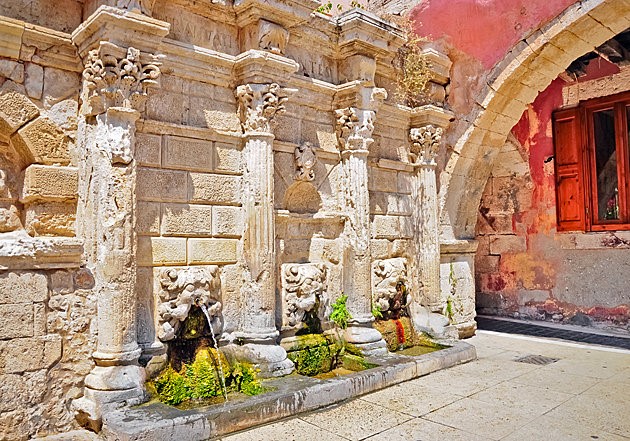 A joy to explore on foot, the cobbled streets of Rethymnon’s car-free old town, takes you back through the centuries. Laid out on a grid system, the mix of architectural styles reflects the town's history, so you'll see attractions such as the 16th-century Venetian loggia, the 17th century Rimondi Fountain with water gushing from the mouths of three stone lions, a towering Ottoman minaret from 1890, a smattering of contemporary graffiti, and modern day cafés and restaurants full of students. Sometimes styles are combined - lovely pastel-colored Venetian-era town houses have wooden balconies added by the Turks. Today, the most touristic area is the old harbor, rimmed with seafood restaurants, which is especially enchanting in the evening.
A joy to explore on foot, the cobbled streets of Rethymnon’s car-free old town, takes you back through the centuries. Laid out on a grid system, the mix of architectural styles reflects the town's history, so you'll see attractions such as the 16th-century Venetian loggia, the 17th century Rimondi Fountain with water gushing from the mouths of three stone lions, a towering Ottoman minaret from 1890, a smattering of contemporary graffiti, and modern day cafés and restaurants full of students. Sometimes styles are combined - lovely pastel-colored Venetian-era town houses have wooden balconies added by the Turks. Today, the most touristic area is the old harbor, rimmed with seafood restaurants, which is especially enchanting in the evening.
Fortezza
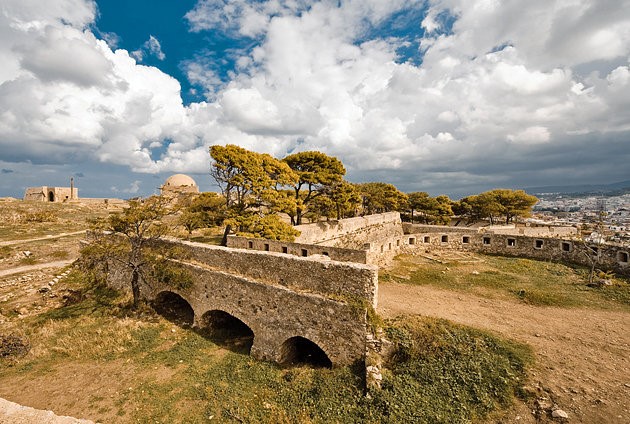 By the 16th century, the Ottoman Turks were fast advancing into Europe. Between 1573 and 1580, the Venetians built this enormous fortress, completed with sturdy bastions, to protect the island against Turkish invasion and also as a place where locals could take shelter, should the Turks take the town. Perched atop Paleokastro hill, immediately west of the old harbor, it affords marvelous views over Réthymnon's old town and out to sea. On the highest point, note the mosque, originally a church, but converted into an Islamic place of worship by the Turks when they eventually conquered the town in 1646. There's also a small open-air theater, which hosts concerts in summer.
By the 16th century, the Ottoman Turks were fast advancing into Europe. Between 1573 and 1580, the Venetians built this enormous fortress, completed with sturdy bastions, to protect the island against Turkish invasion and also as a place where locals could take shelter, should the Turks take the town. Perched atop Paleokastro hill, immediately west of the old harbor, it affords marvelous views over Réthymnon's old town and out to sea. On the highest point, note the mosque, originally a church, but converted into an Islamic place of worship by the Turks when they eventually conquered the town in 1646. There's also a small open-air theater, which hosts concerts in summer.
Arkadi Monastery
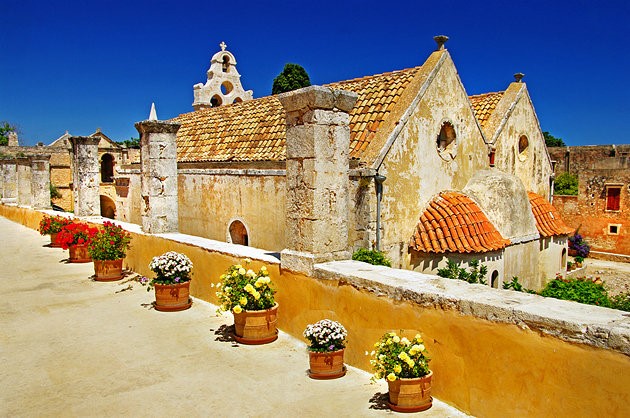 The Orthodox Church played an important role in liberating Greece from Turkish occupation. Set amid the rural foothills of Psiloritis (Mount Idi), 23 kilometers southeast of Réthymnon, this fortress-like 16th-century monastery is surrounded by high stone walls. Today, it's a wonderfully peaceful place, with a delightful Baroque church and a rose garden, but it has not always been so. In 1866, the monastery became the central meeting place for Cretan revolutionaries, with the Abbot as chairman. During an uprising against the Turks, some 900 locals (mainly women and children), who had taken refuge here, chose to blow themselves up rather than surrender. Outside the monastery, their skulls are displayed in glass cabinets, as a haunting monument to their bravery.
The Orthodox Church played an important role in liberating Greece from Turkish occupation. Set amid the rural foothills of Psiloritis (Mount Idi), 23 kilometers southeast of Réthymnon, this fortress-like 16th-century monastery is surrounded by high stone walls. Today, it's a wonderfully peaceful place, with a delightful Baroque church and a rose garden, but it has not always been so. In 1866, the monastery became the central meeting place for Cretan revolutionaries, with the Abbot as chairman. During an uprising against the Turks, some 900 locals (mainly women and children), who had taken refuge here, chose to blow themselves up rather than surrender. Outside the monastery, their skulls are displayed in glass cabinets, as a haunting monument to their bravery.
Argyroupoli
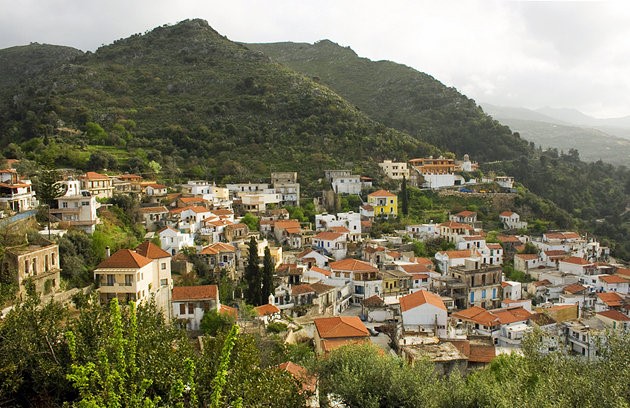 Argiroupoli is the site of the ancient city of Lapa. According to the myths, Lapa was created by Agamemnon, the hero of the Trojan war. The older coins of the city show the goddess Vritomartis Artemis, who was a Cretan goddess influenced by the Minoan religion.
Argiroupoli is the site of the ancient city of Lapa. According to the myths, Lapa was created by Agamemnon, the hero of the Trojan war. The older coins of the city show the goddess Vritomartis Artemis, who was a Cretan goddess influenced by the Minoan religion. The village is lying 27 kilometres southwest of Réthymnon and is especially cool and fresh in summer time due to countless small waterfalls rising from underground springs. Nestled amid lush greenery and trees, Argyroupoli has a rich history dating back to Roman times - it was also much loved by the Venetians, and later became the center of Cretan resistance against the Turks. Today, it is particularly known for its excellent taverns specialising in roast lamb, with open air dining on stone terraces under the trees and close to the waterfalls.
Preveli Monastery
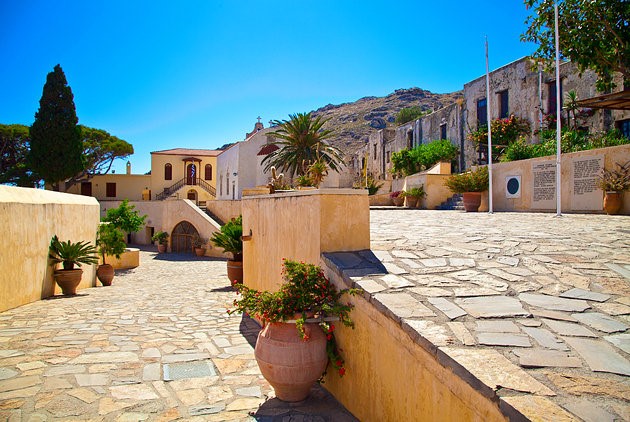 On Crete's isolated south coast, built into a remote hillside overlooking the Libyan Sea, Preveli Monastery lies 36 kilometers south of Réthymnon and is only accessible via a winding road through the mountains. Dating from the 17th-century, the monastery features a church and a small museum displaying icons and ecclesiastical paraphernalia. Outside stands a Memorial for Peace and Resistance, erected in 2002. During the Battle of Crete, in 1941, the monks at Preveli gave supplies and shelter to the Allies. The monument is composed of a large headstone, with an unusual statue of a priest (holding a machine gun) and a soldier (one of the Allies) standing to each side. From here you have absolutely stunning views down onto the sea.
On Crete's isolated south coast, built into a remote hillside overlooking the Libyan Sea, Preveli Monastery lies 36 kilometers south of Réthymnon and is only accessible via a winding road through the mountains. Dating from the 17th-century, the monastery features a church and a small museum displaying icons and ecclesiastical paraphernalia. Outside stands a Memorial for Peace and Resistance, erected in 2002. During the Battle of Crete, in 1941, the monks at Preveli gave supplies and shelter to the Allies. The monument is composed of a large headstone, with an unusual statue of a priest (holding a machine gun) and a soldier (one of the Allies) standing to each side. From here you have absolutely stunning views down onto the sea.
Preveli beach
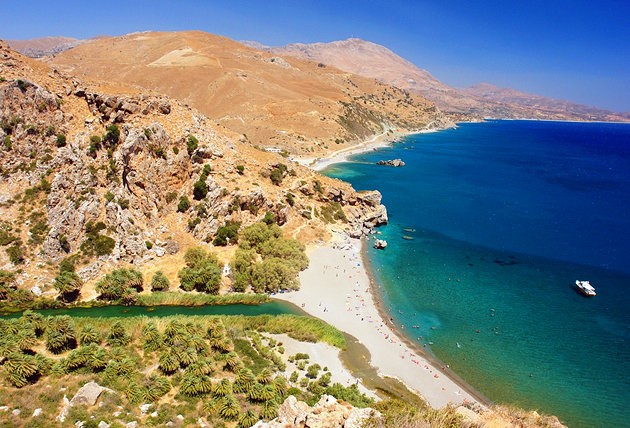 Some of Crete's most beautiful beaches are on the remote south coast extending to the Libyan Sea. Hidden away below Preveli Monastery, this fine pebble beach lies at the delta of a river and is backed by a lush palm grove. If you walk up the gorge, through the palms, you'll find a small waterfall. The beach itself is quite difficult to reach, with a narrow, rocky path leading along the coast from the car park and then a long flight of steps. A small taverna on the beach sells snacks and rents sunbeds. The palms were seriously damaged by fire in 2010, but have naturally regenerated since.
Some of Crete's most beautiful beaches are on the remote south coast extending to the Libyan Sea. Hidden away below Preveli Monastery, this fine pebble beach lies at the delta of a river and is backed by a lush palm grove. If you walk up the gorge, through the palms, you'll find a small waterfall. The beach itself is quite difficult to reach, with a narrow, rocky path leading along the coast from the car park and then a long flight of steps. A small taverna on the beach sells snacks and rents sunbeds. The palms were seriously damaged by fire in 2010, but have naturally regenerated since.
Psiloritis Mountain
Rising 2,456 meters, Psiloritis (also known as Mount Idi) is the highest mountain on Crete and the second highest in Greece, after Olympus. The mountain was sacred to the ancients - the king of gods, Zeus, was supposedly born here. Various adventure sports agencies arrange one-day tours from Réthymnon and Heraklion. Most take you to a decent starting point and then begin a hike through the dramatic, rocky landscape, following a clearly marked path to the summit, which is crowned by the Chapel of the Holy Cross. It normally takes three or four hours to reach the top, and you'll need to be reasonably fit, wear good walking boots, and bring plenty of water. The view from the summit is breathtaking - it overlooks the entire island as well as both the north and south coasts.Ideon Andron
The Ideon Andron cave is situated on the Nida plateau of Mount Psiloritis, 24 km from the village of Anogeia and 78 km from the town of Rethymnon. Initially its extraordinary large entrance impresses visitors to the Ideon Andron, which is at a height of 1538 m with a vast central hall and a gallery of 22 m in length.In antiquity it was a place of worship, because it was believed to be the cave where the goddess Rhea hid the infant Zeus, in order to protect him from his father Cronus. According to a variant of this legend, the Kouretes, a band of mythical warriors, undertook to dance their wild, noisy war dances in front of the cave, so that the clamour would keep Cronus from hearing the infant's crying. Excavations there have unearthed votive offerings, including a well preserved bronze shield, spears and gold and ivory figures. These findings are currently displayed at the Heraklion Archaeological Museum.
Anogeia
 The church of Saint John seems to be the first building of the settlement, which later came to be known as “Anogeia”. Within the temple of Saint John are remains of Byzantine drawings on the walls, which can be dated back to the 11th century.
The church of Saint John seems to be the first building of the settlement, which later came to be known as “Anogeia”. Within the temple of Saint John are remains of Byzantine drawings on the walls, which can be dated back to the 11th century.The holm - oak tree wood should be visited, which is found near the church of Agios Yakinthos, the protector of the lovers; the church is situated at a distance of 18 km far from Anogeia at the South (at the mid-way to the Nida plateau) and it is a beautiful dry stone building. One of the most interesting buildings of the area are the "Mitata", dry stone vaulted constructions used by the stock farmers as provisional dwellings and as places of storage of the local cheese, left there to mature.
If you feel like it during your visit to Anogeia, stop and have a meal at our friend “Gagaris Restaurant” which will serve you the best of Cretan cuisine. The help desk will give you all information needed.
Zoniana - Sfentoni Cave
Zoniana Village is located at Psiloritis (Idi mountain) at an altitude of 630 meters and close to the famous Anogeia. At the entrance to the village is the cave “Sfentoni”. Displays 14 halls, richly ornamented with stalactites and stalagmites. Sfentoni Cave is considered as one of the five best preserved caves in Greece, with rare natural beauty and numerous stalactites and stalagmites. It is 550 m long and covers a total of 3,330 sq.m. During recent years archaeological research has uncovered installations dating back to the Neolithic period in the interior of the cave. The entrance to the cave is allowed with the escort of a guide only.Skinakas Observatory
 The favourable climatological conditions prevailing in Crete (large number of clear-sky nights per year) combined with the high mountains, place the island of Crete among the best locations in Europe for high quality astronomical observations. The Skinakas Observatory has been built and operates as part of scientific research collaboration between the University of Crete, the Foundation for Research and Technology-Hellas (FORTH) and the Max-Planck-Institut fur Extraterrestrische Physik of Germany. The site of the Observatory, chosen on scientific and functional grounds, is the Skinakas summit of Mount Idi (Psiloritis), at an altitude of 1750 m and 60 km from Heraklion.
The favourable climatological conditions prevailing in Crete (large number of clear-sky nights per year) combined with the high mountains, place the island of Crete among the best locations in Europe for high quality astronomical observations. The Skinakas Observatory has been built and operates as part of scientific research collaboration between the University of Crete, the Foundation for Research and Technology-Hellas (FORTH) and the Max-Planck-Institut fur Extraterrestrische Physik of Germany. The site of the Observatory, chosen on scientific and functional grounds, is the Skinakas summit of Mount Idi (Psiloritis), at an altitude of 1750 m and 60 km from Heraklion.Skinakas Observatory offers a number of open days each year in order to make the general public familiar with recent advances in science and technology, depending on the weather conditions.
Other places of interest:
Kournas
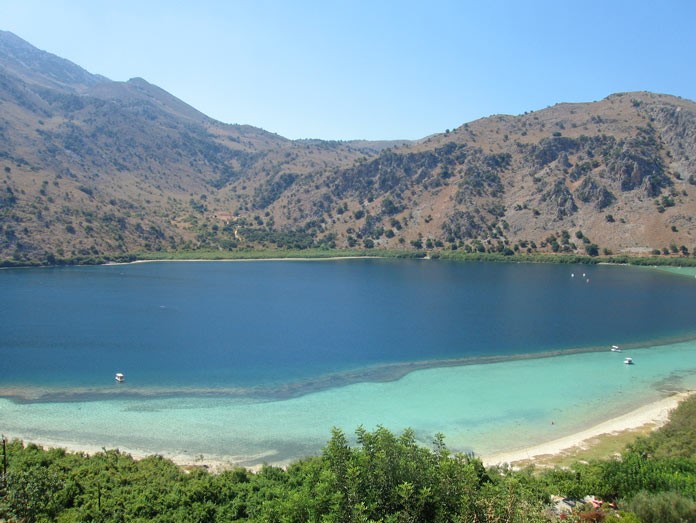 The village of Kournas is 43km from Chania and 20km from Réthymnon on a road turning south at 41km of the Chania - Réthymnon highway. Kournas Lake, old villages, Byzantine churches, a Minoan tomb and a cave are in the area around the village. The old village of Kournas maintains aspects of traditional Cretan village architecture and there are several Byzantine churches. A few kilometers from the lake of Kournas, the village is nowadays a favourite place for traditional local cuisine, especially in the winter. Lake Kournas is one of only two lakes in Crete and covers a total area of about 160,000 square metres with a depth of up to 25 metres. A strip of white sand beside the lake provides an area for swimming and cafes.
The village of Kournas is 43km from Chania and 20km from Réthymnon on a road turning south at 41km of the Chania - Réthymnon highway. Kournas Lake, old villages, Byzantine churches, a Minoan tomb and a cave are in the area around the village. The old village of Kournas maintains aspects of traditional Cretan village architecture and there are several Byzantine churches. A few kilometers from the lake of Kournas, the village is nowadays a favourite place for traditional local cuisine, especially in the winter. Lake Kournas is one of only two lakes in Crete and covers a total area of about 160,000 square metres with a depth of up to 25 metres. A strip of white sand beside the lake provides an area for swimming and cafes.
Souda islet
 Souda is an islet in Souda Bay on the northwest coast of Crete at the entrance of the bay of Souda. In ancient times this islet was one of two islets that were referred to as Leukai. The second islet is known today as Leon. On top of the islet there is the monastery of St. Nicolas which has been fortified and renamed to "Souda" after the gulf. The old monastery of Agios Nikolaos is still surviving. Musical contest between the Sirens & the Muses. In ancient times, the two islands were called Lefkai (White), as their name came from an ancient Greek myth in which it is said that the Sirens were defeated by the Muses in a music game out of their anguish their feathers fell from their shoulders, got white and remained in to sea and the islands were shaped
Souda is an islet in Souda Bay on the northwest coast of Crete at the entrance of the bay of Souda. In ancient times this islet was one of two islets that were referred to as Leukai. The second islet is known today as Leon. On top of the islet there is the monastery of St. Nicolas which has been fortified and renamed to "Souda" after the gulf. The old monastery of Agios Nikolaos is still surviving. Musical contest between the Sirens & the Muses. In ancient times, the two islands were called Lefkai (White), as their name came from an ancient Greek myth in which it is said that the Sirens were defeated by the Muses in a music game out of their anguish their feathers fell from their shoulders, got white and remained in to sea and the islands were shaped
Lefka Ori (White Mountain)
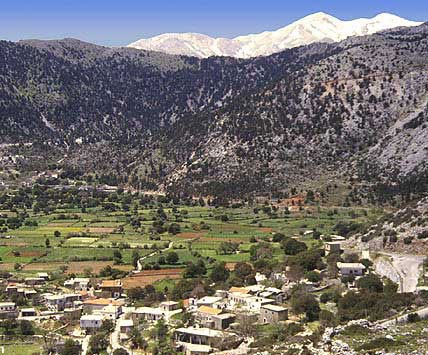 The Lefka Ori (White Mountain) rise behind Chania and drop to the Libyan Sea in Sfakia. Surround the plateau with the high peaks of Kastro on the west, Tripali on the east and Agathes giving it the appearance of an amphitheatre. The plateau of Askifou was probably a lake in prehistoric times and the fertile patchwork fields yield wheat and potatoes. On this plateau in 1821 there was a major battle between the Turks and the Sfakiani revolutionaries that resulted in a victory for the locals. The fierceness of the battle and the heroic fighters are still remembered in local songs.
The Lefka Ori (White Mountain) rise behind Chania and drop to the Libyan Sea in Sfakia. Surround the plateau with the high peaks of Kastro on the west, Tripali on the east and Agathes giving it the appearance of an amphitheatre. The plateau of Askifou was probably a lake in prehistoric times and the fertile patchwork fields yield wheat and potatoes. On this plateau in 1821 there was a major battle between the Turks and the Sfakiani revolutionaries that resulted in a victory for the locals. The fierceness of the battle and the heroic fighters are still remembered in local songs.
Botanical Park of Crete
A green oasis of 20 hectares between Chania and Réthymnon, containing all kinds of herbs and fruits tree from Crete, the Mediterranean and tropical countries. The Botanical Park of Crete offers you the opportunity to walk in the countryside, relax, admire the plants and animals, and learn about them and their way of life. If your stroll has given you an appetite, the restaurant awaits, with Cretan dishes cooked in the wood oven or in other old, traditional ways which bring out the flavours of the pure products of our land.During the summer months, the best time to schedule your visit is early in the morning, avoiding the strong heat and having the opportunity to complete your experience with an excellent meal in the park’s restaurant. Its totally local, organic and seasonal philosophy will be unforgettable.
Cretaquarium
This is where the experience exploring the Mediterranean Sea world begins. There are one hundred observation points for visitors to admire approximately 2,500 Mediterranean and tropical organisms. A full tour taking in all exhibits and species lasts about 2 hours. The Cretaquarium building complex is situated in the grounds of the former American Base at Gournes, 14 km from the city of Heraklion and Nikos Kazantzakis International Airport. It lies 20km from the Minoan palace of KnossosGlassmaker:
Kokkino Horio Apokoronou Chania, Tel: +30 28250 31194Festivals and cultural events of Réthymnon
Réthymnon is a city with long history. Throughout the year, many local festivals take place in the villages. These are religious celebrations and other events always accompanied by excellent wine, food and music.Religious feasts & festivals
April 23rd
The feast of Agios Georgios is greatly celebrated in Zoniana and Plakias on April 23rd (or the first Monday after Easter).August 15th
On the 15th of August, celebrations are held to honor the Dormition of the Holy Virgin, the largest religious celebration in Greece. The great feast is accompanied by food, wine and traditional dances. At the same time, various festivities take place all around the country.September 8th
On the 8th of September, in the village of Myriokefala, there is a lovely feast with hundreds of pilgrims. The locals celebrate the miraculous icon of Virgin Mary which is kept in the Byzantine church of the village.Cultural events
November 8th
On the 8th of November, the locals commemorate the Arkadi Holocaust. A religious ceremony is held in the monastery of Arkadi, where in 1866 the Cretan flightets exploded themselves in order to avoid surrendreing to the Ottomans. The locals bring flowers to the monastery to honor the dead.Yakynthia Festival
Yakinthia Festival takes place in late July/ early August in the village of Anogeia. This festival includes theatre performances, traditional group dancing and live Cretan music.Carnival of Réthymnon
The Carnival of Réthymnon is very popular in Greece. Festivities last for two weeks and include treasure hunts, musical events and a large parade in Carnival Sunday.Rennaissance Festival
The Rennaissance Festival takes place from late August to early September in various venues of Réthymnon Town. The events include theatre performances of Medieval plays, concerts of Medieval age and exhibitions of baroque art.* Please note that dates may vary and are given as indicative only.
Gorges and Caves
Crete is a blessed and privileged place with a mild climate during the whole year, countless beauties and all kinds of attractions with. More than 60 small and bigger gorges, easy or difficult of access with legends about dragons and fairies, about good and bad spirits that dwell in the gorges. There are limpid water sources or picturesque Byzantine churches in such places where famous oracles or pantheons formerly took place. Herewith, a small list of 10 gorges, which does not mean that the other gorges are devoid of beauties and of interest.1. The Gorge of Samaria |
6. The Sfakian Gorge |
2. The Gorge of Imbros in Sfakia |
7. The Gorge of Trypitis |
3. The Gorge of Agia Irini in Selino |
8. The gorge of Kladou in Sfakia (Domata) |
4. The Gorge of Aradaina in Sfakia |
9. The Gorge of Diktamou (Katechori Stilos) |
5. The Gorge of Elygia |
10. The Gorge of Therisso or Eleytheriou Venizelou |
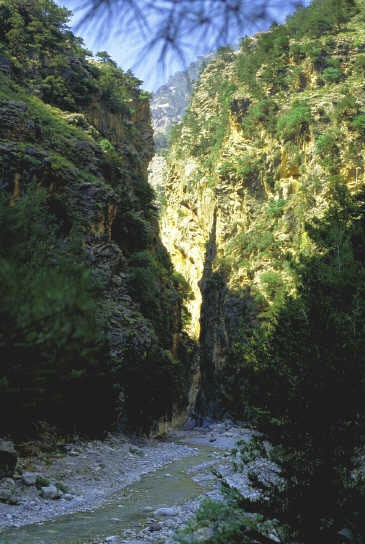 The Gorge of Samaria
The Gorge of Samaria
The gorge of Samaria is the biggest, most imposing and beautiful gorge in Chania and in Europe and that is why it is internationally renown and mostly visited, since more than 300’000 people have the opportunity to cross it each year. It has a wonderful landscape with rare geo-morphological formations. It is a unique biotope with particular richness in fauna and flora. Characteristics:
Altitude: Fifty eight peaks over 2000 m. in altitude
Length: 12,800 km to the limits of the park - Distance to the coast: another 3,200 km
Estimated time: Around 5 hours crossing it at a good pace
Time of visit: Beginning of May till the end of October depending on the weather conditions
Fauna: World-famous Cretan Chamois (wild goat) an extremely beautiful and dashing animal that has been preserved and is now living freely in the gorge of Samaria
Flora: A total of 450 species of Cretan flora in the gorge, of which 70 are endemic, i.e. they grow in the gorge only.
The Gorge of Imbros in Sfakia
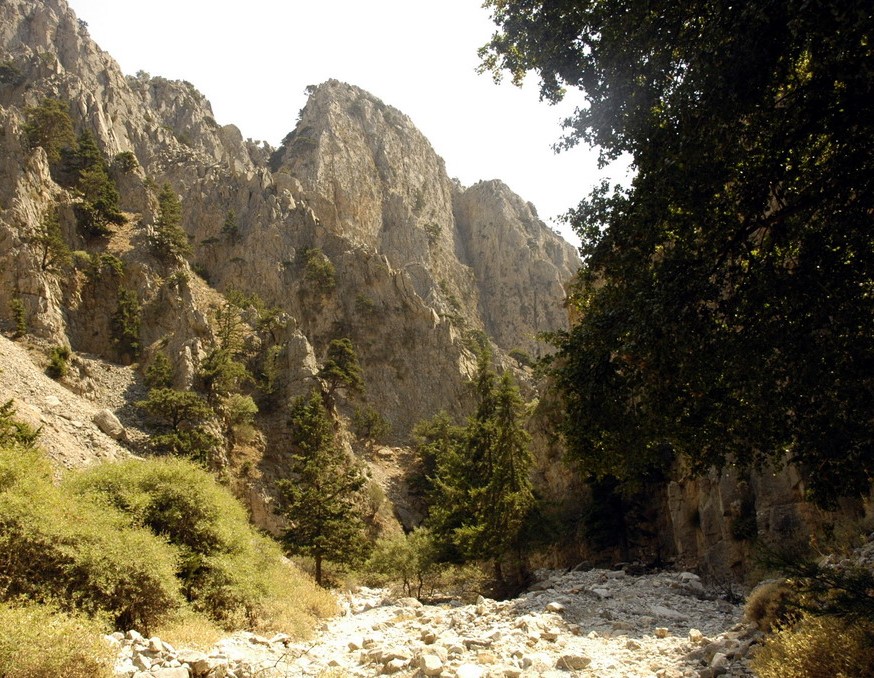 It is a small but very beautiful gorge visited each year by around 50.000 people, due to the ease with which can be crossed at any time of the year, especially when the gorge of Samaria is closed.
It is a small but very beautiful gorge visited each year by around 50.000 people, due to the ease with which can be crossed at any time of the year, especially when the gorge of Samaria is closed.Its crossing starts from the Sfakian mountain village called Imbros, situated at an altitude of 780 m and a distance of 55 km from Chania. The gorge is 8 km long and its crossing takes about 2 hours. It has impressive “gates” or entrances i.e. narrow vertical rocky passes that, like a tunnel, almost obstruct the view to the sky in the middle of the passage and the narrowest spot is only 2 m wide. The gorge ends in the asphalt road that connects Chora Sfakion westwards (4.800 km) to the reputed fortress and beach of Fragokastello (10 km) eastwards. There are taverns at the exit as well.
MUSEUMS (Réthymnon Prefecture)
Archaeological Museum: Fortezza, Tel: +30 28310 54668Opening hours: Tues - Sun: 08:00-17:00, closed on Monday
Historical and Folklore Museum: 28-30 M. Vernadou, Tel: +30 28310 23398,
Opening hours: Daily 10:00-14:30, closed on Sunday
Paleontological Museum: Temple of Mastaba, Tel: +30 28310 23083
Opening hours: Monday to Saturday 09.00-15.00, closed on Sunday
Ecclesiastical Museum: 3 Vasileiou Chali (by Metropolis Square), Tel: +30 28310 22415, 22731
Opening hours: Monday to Saturday 10:00-15:00, closed on Sunday
Contemporary Art Gallery “L.Kanakakis”: 5 Cheimaras Str., Tel: +30 28310 55847, 52530
Opening hours APR-OCT: Tue-Fri 09:00-13:00 & 19:00-22:00, Sat-Sun 11:00-15:00, closed on Monday
Oriseum Museum: Asomatos, Rethymnon, Tel: +30 28320 31674
Opening hours are daily from 10:00 a.m. to 3:00 pm
Marine Museum: 48 Arampatzoglou Str., Rethymnon, Tel: +30 28310 40150
Opening hours: Daily 08:30-15:00, closed on Sunday and Monday
Military Museum: Chromonastiri (11klm southeast of Rethymnon), Tel: +30 28310 75135
Opening hours: Summer Season (1st May - 31st October), Tue-Fri 10:00-18:00, Sun 10:00-14:00, closed on Monday and Saturday
Museum of Cretan Lyra: 45 Hatzimichali Giannari Str., Rethymnon Town, Tel: +30 2831030831
Opening hours: Mon-Wed-Sat 10:00-14:00, Tue-Thu-Fri 10:00-14:00 &18:00-21:00, closed on Sunday
Wax Museum, Potamianos: Zoniana Mylopotamos, Tel: +30 28340 61087
Opening hours: Mon-Sun 10:00 - Sunset
Central of Cretan Popular art: 15-17 Kritovoulidou Str, Rethymnon, Tel: +30 28310 51501, 29362
Opening hours: Mon - Fri: 9:00 -14:00, closed on Saturday & Sunday
*All time schedules are indicative
Activities
Water Sports
Nearby, visitors can indulge in banana boat rides, windsurfing, paragliding, scuba-diving and sailing.Boat Trips
Day trips can be organised in most Travel Agencies to Santorini, Spinalonga, Gramvoussa-Balos and more. Regular boats depart from the harbour of Souda, taking visitors to hidden coves and nearby resorts, as well as out on day trips to Spinalonga Island and Santorini. There are also boat trips out on the lake Kournas and pedalo rides.Walking & Hiking
The stunning countryside inland, dotted with vineyards, olive groves and with the scenic White Mountains as the backdrop, is ideal for walks and hikes, with plenty of routes and paths to follow. Horse-riding and cycling is also available, and is an ideal way to get up close to the natural beauty of the region.Day Trips
The waterfalls and springs of Argiroupolis are nearby, whilst Chania and Heraklion are easy to reach. The capital, Heraklion, is a popular day trip, as is Knossos and the Samaria Gorge.In the village
The chapel of St Nicholas is worth a visit. There are lots of local food options as well as English food, and places to drink include the Cotton Bar and Sinatra’s. If you are up early take the time to watch the local fishermen unload the early morning catch in the harbour.Bird Watching
The best time to visit the island for bird-watching is the spring and the beginning of the summer, which does not mean that autumn and winter are not good too. Visitors that are interested in the migration of birds are advised to visit the area of Chrisoskalitissa and Elafonisos, at the western coast as well as the three capes of the prefecture.For the observation of water birds the best places are Georgioupolis, Lake Kournas, Souda Bay (especially the outflow of river Moronis), Lake Ayia and the coastline west of Chania until after Kastelli, in Phalassarna where rivers like Keritis, Tavronitis and Skoutelonas flow.